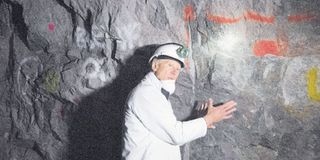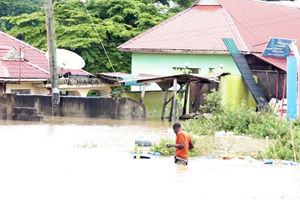South Africa rare earths mine hopes for boost

Trevor Blench, Steenkampskraal (SKK) Holdings Chairman, shows where the monazite reef(darker rock) containing the rare-earth minerals is, underground at the SKK rare-earth mine on July 29, 2019, about 80Km from the Western Cape town of Vanrhynsdorp. - SKK has been confirmed as one of the highest grade deposits of rare-earth minerals in the world. The rare-earth minerals are used in the manufacture of powerful magnets, which are used in electric vehicles, wind turbines, robotics, and many other applications. The mine also produces naturally occurring radioactive thorium, which is used in medical and power generation applications. (Photo by RODGER BOSCH / AFP)
What you need to know:
The mine, located about 350 kilometres (220 miles) north of Cape Town, used to produce thorium, a component of nuclear fuel, in the 1950s and 60s
Cape Town. It’s old, doesn’t look like much and is located well out the way in an arid part of western South Africa.
But the Steenkampskraal Mine may be about to become piping hot mining property thanks to some of the world’s highest-grade deposits of rare earth metals.
“Steenkampskraal will become a very important source of rare earths for the global industry,” Trevor Blench, chairman of Steenkampskraal Holdings Limited, said during a recent tour.
The mine, located about 350 kilometres (220 miles) north of Cape Town, used to produce thorium, a component of nuclear fuel, in the 1950s and 60s.
But now it’s been found to also have monazite ore which contains extremely high grade rare earth minerals including neodymium and praseodymium -- elements vital to cutting-edge industries.
Manufacturing uses range from tinted welding goggles to industrial magnets, strong alloys for aircraft engines, military hardware, hybrid cars, consumer electronic devices, medical equipment and even the flints in cigarette lighters.
China produces the largest share of so-called “tech minerals”, with a domestic output of 120,000 tonnes in 2018. That’s vastly more than the United States, which relies on China for about 80 percent of its rare-earth imports.
But now Beijing has threatened to cut off the supply as trade frictions mount, prompting US President Donald Trump on July 22 to give the Pentagon an executive order to find other sources of the crucial elements.
Rare earth elements are a group of 17 minerals unique for their magnetic, catalytic and electrochemical properties.
For the first time since 1985, China last year became a net importer of some rare earths for its industrial needs, while the government cracked down on illegal exploration and production.
Global sales of electric cars, which need the minerals, jumped by 68 percent in 2018 to 5.12 million, with China selling over a million vehicles, according to the International Energy Agency.
“China may, as a result of its own requirements, just export less and less to the rest of the world,” Blench said.
Steenkampskraal Mine could just be the answer to growing demand, he suggested.
“About 14 percent of this rock is rare earths. That is an extraordinarily high grade and we don’t know anything like it on the planet,” Blench said, holding a small but heavy reddish brown rock.
Worldwide, many mines have around six percent or less rare earths in their ore.
No mines for rare earth elements currently operate in South Africa, but the government confirms the presence of yet-to-be tapped tech minerals. (AFP)




